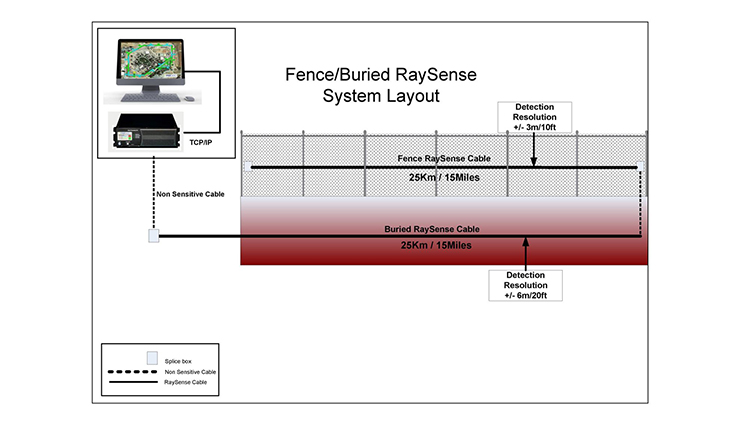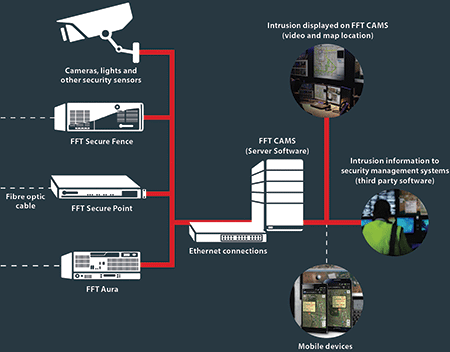Improve Your Safety And Security With Advanced Fiber Optic Safety And Security Systems
In an age where safety is vital, advanced fiber optic protection systems offer an engaging option for boosting security across different atmospheres. What effects do these advancements hold for future security steps?
Benefits of Fiber Optic Safety And Security
Utilizing the benefits of fiber optic technology dramatically boosts security systems throughout various applications. Among the key advantages is the enhanced data transfer ability, enabling the transmission of large quantities of data at broadband. This is particularly crucial for real-time video surveillance, where high-resolution feeds can be sent without latency, guaranteeing instant response capabilities.
Furthermore, optical fiber show remarkable resistance to electro-magnetic disturbance, which is crucial in atmospheres with potential signal interruptions. This dependability makes sure constant performance in important safety and security procedures. Fiber optic cable televisions are much less prone to tapping and unauthorized accessibility compared to traditional copper circuitry, consequently improving information integrity and confidentiality.
Another remarkable advantage is the toughness of fiber optic systems; they are a lot more resistant to ecological factors such as wetness, temperature level changes, and harsh compounds. This resilience equates to decrease upkeep costs and longer life expectancies for security installations.
Last but not least, the light-weight nature of fiber optic cable televisions promotes much easier installation and transmitting, especially in complex infrastructures (fiber optic security system). Ultimately, the integration of fiber optic innovation into safety and security systems not only reinforces security measures however likewise optimizes operational efficiency
Key Attributes to Think About
When reviewing fiber optic safety and security systems, a number of crucial features must be considered to make sure ideal efficiency and effectiveness. Analyze the system's detection range and sensitivity; a considerable array permits for checking large areas, while high level of sensitivity ensures that also small disturbances are discovered without delay.
Next, consider the combination capabilities of the system. A fiber optic safety system should seamlessly user interface with existing safety procedures such as cams and alarms, creating a cohesive security network.
Durability and environmental resistance are likewise critical features. Guarantee that the system is developed to endure harsh climate condition and prospective physical threats, as this will prolong its operational life expectancy.

Last but not least, explore the scalability of the system. A robust fiber optic security system ought to be easily expanding to suit future needs without considerable overhauls. By very carefully thinking about these features, you can choose a fiber optic safety service that improves security and security in your environment.
Installation Refine Overview
To efficiently apply a fiber optic safety system, a systematic installment procedure is essential. This process begins with an extensive site evaluation to figure out the certain protection demands and to recognize ideal places for fiber optic wires and safety and security gadgets. Following this evaluation, the setup group will certainly establish an in-depth plan, including cable television pathways, needed tools, and compliance with neighborhood regulations.
Next, the setup entails laying the fiber optic cable televisions, guaranteeing they are secured from ecological elements and physical damage. Appropriate handling techniques are important, as fiber optic wires are delicate and can see this page be easily harmed. After the cabling is set up, ports and discontinuations are carefully completed to ensure signal integrity.
The subsequent stage includes setting up safety devices such as electronic cameras, movement detectors, and security system, all incorporated with the fiber optic network. Rigorous screening is carried out to validate that all parts are working appropriately and to ensure optimum efficiency.

Comparing Fiber Optic to Typical Systems
The evolution of safety and security modern technology has actually brought about substantial innovations in the contrast between fiber optic systems and typical copper-based systems. Fiber optic systems utilize light to transmit information, using exceptional bandwidth and rate contrasted to their copper equivalents. This causes boosted information transmission capacities, making fiber optics perfect for high-resolution video clip security and real-time monitoring.
In addition, fiber optic cable televisions are immune to electro-magnetic interference, decreasing the probability of signal degradation caused by exterior variables. This characteristic makes sure constant performance, even in tough atmospheres. In contrast, standard copper systems are more vulnerable to disturbance, resulting in possible vulnerabilities in safety and security applications.
Toughness is one more benefit of fiber optic systems. They are less vulnerable to harm from ecological elements such as dampness and temperature fluctuations, which can endanger copper circuitry. Moreover, fiber optics are lighter and thinner, enabling easier installation and decreased physical footprint.
Nonetheless, typical systems have a tendency to have lower initial prices, making them appealing for budget-conscious tasks. While fiber optic systems might call for a greater in advance investment, their lasting advantages-- such as reduced maintenance costs and higher dependability-- often surpass the preliminary expenditure, placing them as a premium option for modern-day security requirements.
Future Patterns in Protection Technology
Arising trends in safety and security technology are poised to change the landscape of surveillance and threat detection - fiber optic security hop over to these guys system. As organizations increasingly encounter advanced hazards, advancements such as synthetic intelligence (AI) and device understanding (ML) are coming to be integral to safety systems. These technologies enhance the ability of fiber optic systems by allowing real-time information analysis, determining anomalies, pop over to these guys and automating reactions to possible violations
In addition, the integration of the Web of Things (IoT) is transforming security structures. IoT gadgets can provide thorough situational recognition and assist in seamless communication between various safety components. This interconnectedness permits a lot more effective surveillance and faster case response times.
Biometric verification is likewise acquiring energy, supplying a higher degree of protection through distinct physical attributes. As this technology advances, it is likely to be included right into fiber optic systems for improved accessibility control.
Final Thought
In final thought, progressed fiber optic safety and security systems represent a substantial improvement in safety and security and surveillance innovation. The shift from typical systems to fiber optic services mirrors a growing pattern in the direction of extra effective and reliable safety and security steps in an increasingly complex technical landscape.